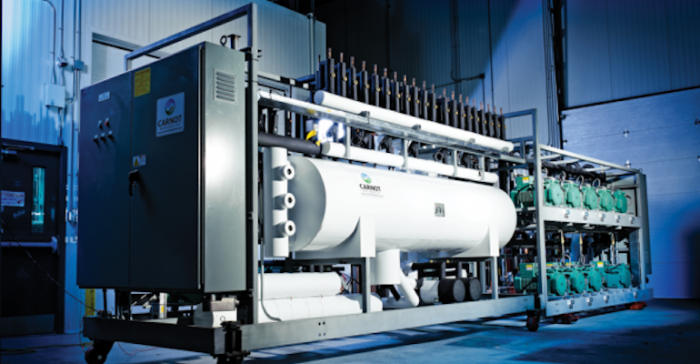Bryan Kilgore, ERS, for Zondits
DeCicco & Sons, a New York grocery store chain, installed a transcritical CO2 refrigeration system at their store in Larchmont, NY. They recently compared the energy consumption at their Larchmont store to their similarly sized store in Ardsley, NY, that has a comparable refrigeration load, but with an R-404A refrigeration system. They found that the transcritical CO2 refrigeration system operated with a lower energy consumption and power demand throughout the year, even during the warmer months when it was expected to operate less efficiently. Transcritical CO2 systems typically take a sizable efficiency hit when the condenser/gas cooler requires CO2 gas temperatures above the critical point at 88°F.
DeCicco & Sons mitigated this problem by installing an adiabatic condenser. An adiabatic condenser is effectively an air-cooled condenser with pre-cooled ambient air. The air drawn into the condenser passes through a wetted mesh or pad, where water is sprayed onto the mesh. This pre-cooled air then passes over the condenser coils. The adiabatic condenser allows for lower condensing temperatures keeping CO2 gas temperatures below the 88°F critical point more often.
N.Y. store with transcritical cuts annual energy costs by $74,000
R744, April 3, 2017
DeCicco’s & Sons, a seven-store food retailer based in Pelham, N.Y., saved $74,000 in energy consumption and power demand over a 12-month period as a result of using a transcritical CO2 booster refrigeration rather than a traditional HFC system.
DeCicco’s compared its store in Larchmont, N.Y., which has operated a transcritical system from Hillphoenix for 15 months, with another of its stores in Ardsley, N.Y., which has a conventional R404A system. Both stores were similar in size and refrigeration load (1 million BTUs medium temperature, 200,000 BTUs low temperature); they also employed the same equipment, such as LED lights, anti-sweat heaters and variable-frequency drives, except for the refrigeration system. (The Larchmont store also has solar panels, which were not included in the comparison.)
“Even in months when I expected the CO2 system to be higher [in energy consumption] like June-September, it never really was,” said John DeCicco, Jr., president of the company, in a presentation last week at the AAA Refrigeration/Hillphoenix 8th annual Symposium in Tarrytown, N.Y. He attributed that to the system’s Trillium adiabatic condenser, from Baltimore Aircoil, which keep the temperature of CO2 gas from exceeding 88°F, CO2’s critical point.
“During the winter months, there was a really big savings,” he added. The reduction in energy consumption alone was about 292,000 kWh over the 12 months, a savings of $55,000. The power demand reduction over that period was 720 kW, or 60 kW/month.In addition to the savings in energy consumption and demand, the transcritical system offers 1.1 million BTUs in recovered heat, used throughout the store.
